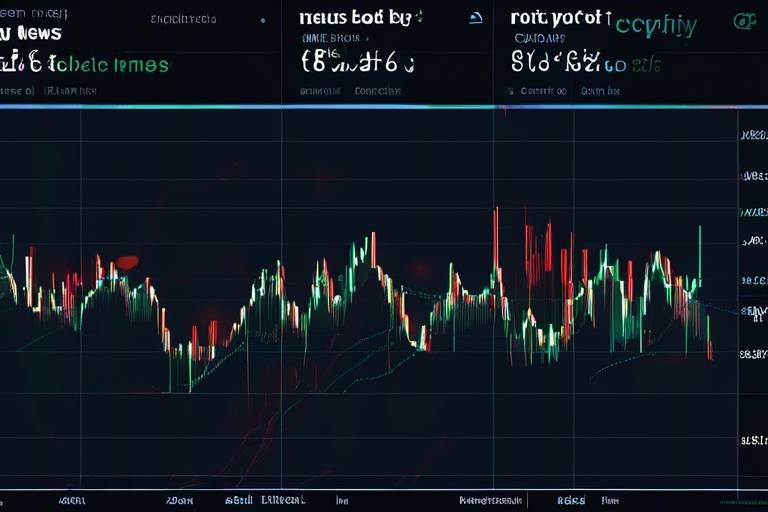Market Predictions - Key Drivers for Bitcoin's Future
Bitcoin, the pioneering cryptocurrency, has captured the imagination of both investors and the general public alike. As we venture further into the digital age, understanding the key drivers that will shape Bitcoin's future is more crucial than ever. With its price swinging wildly, the market is often likened to a roller coaster, full of ups and downs that can leave even seasoned traders feeling dizzy. But what exactly are the factors that will influence Bitcoin's trajectory? In this article, we'll explore the critical elements—ranging from market trends and regulatory frameworks to technological advancements and investor sentiment—that could dictate where Bitcoin is headed. Grab your virtual seatbelt; it’s going to be an exhilarating ride!
Understanding current market trends is essential for predicting Bitcoin's future. The cryptocurrency market operates much like a living organism, constantly evolving and reacting to various stimuli. Price movements can be influenced by a plethora of factors, including trading volumes and historical patterns. For instance, during bullish markets, we often see a surge in trading volumes, akin to a crowd cheering on their favorite team. Conversely, bearish markets can lead to a significant drop in trading activity, leaving investors feeling anxious and uncertain. Historical data can provide valuable insights, revealing that Bitcoin has gone through several boom and bust cycles, each teaching us something new about market behavior.
The regulatory landscape plays a significant role in shaping Bitcoin's future. As governments around the world grapple with how to regulate this digital asset, the implications for investors and the broader cryptocurrency market are profound. Current regulations vary widely from one country to another, creating a patchwork of rules that can be confusing for investors. Potential changes in regulation could either bolster trust in Bitcoin or drive it underground. For example, a country that embraces cryptocurrency could see increased adoption, while one that imposes strict regulations may stifle innovation. Understanding these nuances is critical for anyone looking to navigate the cryptocurrency space.
Technological developments, such as blockchain improvements and scalability solutions, can significantly impact Bitcoin's utility and adoption. Think of Bitcoin as a car; without regular maintenance and upgrades, it may struggle to keep up with the competition. Recent innovations like the Lightning Network aim to make transactions faster and cheaper, potentially increasing Bitcoin’s appeal for everyday use. As technology continues to advance, the possibilities for Bitcoin's growth are limitless. The key will be to stay ahead of the curve and adapt to new developments that could enhance its functionality.
Investor sentiment can drive market fluctuations and influence Bitcoin's price. The psychology of investors is a fascinating subject; it often resembles a game of chess, where emotions can dictate moves. Public perception plays a crucial role in shaping market dynamics. When the news is positive, you can almost feel the excitement in the air, leading to increased buying activity. However, negative news can send shockwaves through the market, causing panic selling. Understanding this psychological aspect can provide valuable insights into potential market movements and help investors make informed decisions.
Global economic conditions, including inflation rates and monetary policy, can impact Bitcoin's appeal as a store of value. In times of economic uncertainty, many investors turn to Bitcoin as a hedge against inflation, much like they would with gold. The relationship between traditional financial systems and cryptocurrencies is becoming increasingly intertwined. As central banks around the world adjust their monetary policies, Bitcoin's positioning as a 'digital gold' could either strengthen or weaken, depending on how investors perceive its value in relation to fiat currencies.
The increasing interest from institutional investors is a key driver for Bitcoin's future. When large financial institutions begin to invest in Bitcoin, it lends a level of legitimacy to the cryptocurrency that can attract a broader audience. Notable investments from companies like MicroStrategy and Tesla have already made headlines, showcasing a growing trend. As more institutions enter the market, we may see increased stability and a shift in market dynamics, paving the way for Bitcoin to become a mainstream asset.
The rise of alternative cryptocurrencies poses challenges for Bitcoin. While Bitcoin remains the dominant player, new digital assets are emerging, each vying for attention and investment. These competing cryptocurrencies often offer unique features or technological advancements that could lure investors away from Bitcoin. Understanding the competitive landscape is crucial for predicting Bitcoin's market position and future growth. As the saying goes, "Keep your friends close, but your competitors closer."
Security issues and fraud in the cryptocurrency space can undermine investor confidence. High-profile hacks and scams often make headlines, creating a sense of fear among potential investors. The importance of robust security measures cannot be overstated; they are the backbone of trust in the cryptocurrency ecosystem. Addressing these concerns is essential for Bitcoin's adoption and market stability. As security technologies advance, they will play a pivotal role in restoring faith and encouraging wider participation in the market.
Making accurate predictions about Bitcoin's future requires analyzing various factors. By synthesizing insights from market trends, regulatory environments, technological advancements, and investor sentiment, we can begin to formulate potential scenarios for Bitcoin's trajectory in the coming years. While it’s impossible to predict the future with absolute certainty, understanding these dynamics can provide a roadmap for navigating the ever-changing landscape of cryptocurrency.
- What is Bitcoin? Bitcoin is a decentralized digital currency that allows for peer-to-peer transactions without the need for intermediaries.
- How does Bitcoin work? Bitcoin operates on a technology called blockchain, which records all transactions in a secure and transparent manner.
- Why is Bitcoin so volatile? Bitcoin's price is influenced by various factors, including market sentiment, regulatory news, and technological developments.
- Can Bitcoin be regulated? Yes, governments can impose regulations that affect how Bitcoin is traded and used, which can impact its price and adoption.
- What are the risks of investing in Bitcoin? Risks include market volatility, regulatory changes, and security vulnerabilities, among others.

Market Trends and Analysis
Understanding current market trends is essential for predicting Bitcoin's future. Over the past few years, Bitcoin has experienced remarkable volatility, with its price oscillating dramatically. For instance, in late 2017, Bitcoin hit an all-time high near $20,000, only to plummet to around $3,000 by early 2019. Such fluctuations can be attributed to various factors, including market sentiment, regulatory changes, and technological advancements. Observing these price movements offers valuable insights into the cryptocurrency's behavior, helping investors make informed decisions.
Another critical aspect to consider is trading volume, which serves as a barometer for market activity. A surge in trading volume often indicates heightened interest and can lead to price increases. Conversely, declining volumes may signal waning interest, potentially resulting in downward price pressure. For example, during the recent bull run in 2021, Bitcoin saw unprecedented trading volumes, which contributed to its meteoric rise. This correlation between trading volume and price movements is something every investor should keep a close eye on.
Historical patterns also play a significant role in market analysis. Bitcoin tends to follow a cyclical pattern known as the "halving cycle," which occurs approximately every four years. During these events, the reward for mining Bitcoin is halved, leading to a decrease in the rate of new Bitcoin entering circulation. Historically, these halvings have been followed by substantial price increases, as reduced supply meets growing demand. Understanding these cycles can provide investors with a framework for anticipating future price movements.
Moreover, one cannot overlook the impact of macroeconomic factors on Bitcoin's market trends. Events such as global economic downturns or inflationary pressures often lead investors to seek alternative assets like Bitcoin as a hedge against traditional financial systems. In recent years, we've seen a growing trend of institutional investors entering the cryptocurrency market, further legitimizing Bitcoin as a viable asset class. This shift in investor demographics is crucial, as it can lead to increased stability and less volatility in the long run.
In summary, analyzing market trends and historical patterns is vital for anyone looking to navigate the ever-changing landscape of Bitcoin. By understanding price movements, trading volumes, and the cyclical nature of Bitcoin, investors can position themselves strategically to capitalize on future opportunities. As we move forward, keeping an eye on these trends will be essential for predicting Bitcoin's trajectory in the coming years.
- What are the key indicators to watch for Bitcoin price movements?
Key indicators include trading volume, market sentiment, and historical price patterns, particularly around halving events.
- How does global economic health affect Bitcoin?
Economic downturns and inflation often drive investors to seek alternative assets, increasing Bitcoin's appeal as a store of value.
- What role do institutional investors play in Bitcoin's market trends?
Institutional investors bring significant capital and legitimacy to the market, which can lead to increased stability and less volatility.

Regulatory Environment
The regulatory landscape surrounding Bitcoin is not just a backdrop; it’s a dynamic force that shapes the entire cryptocurrency ecosystem. As governments and regulatory bodies around the world grapple with how to handle digital currencies, the implications for Bitcoin are profound. Imagine trying to navigate a maze while the walls are constantly shifting—that’s what investors face in this environment. Regulatory clarity can either be a beacon guiding Bitcoin to new heights or a barrier that stifles its growth.
Currently, we see a patchwork of regulations across different jurisdictions. In some countries, Bitcoin is embraced as a legitimate asset, while in others, it faces stringent restrictions or outright bans. For instance, nations like El Salvador have adopted Bitcoin as legal tender, showcasing a progressive stance that could encourage other countries to follow suit. On the flip side, countries like China have cracked down on cryptocurrency trading and mining, creating a chilling effect on market activity.
Understanding these regulatory frameworks is crucial for investors. In many cases, regulations can dictate market behavior. For example, when the U.S. Securities and Exchange Commission (SEC) hinted at increased scrutiny over cryptocurrency exchanges, it sent ripples through the market, leading to a temporary dip in prices. This kind of volatility underscores the necessity for investors to stay informed about potential regulatory changes that could impact their holdings.
One of the most significant challenges in the regulatory environment is the lack of uniformity. To illustrate this, consider the following table that highlights different regulatory approaches in various regions:
| Region | Regulatory Approach | Impact on Bitcoin |
|---|---|---|
| United States | Regulatory scrutiny with ongoing discussions | Increased volatility, potential for clearer regulations |
| European Union | Proposed MiCA regulation for clearer framework | Potential for increased institutional adoption |
| China | Strict bans on trading and mining | Market contraction and loss of mining power |
| El Salvador | Legal tender status for Bitcoin | Potential for increased adoption and tourism |
As we look to the future, the regulatory environment will continue to evolve. This evolution could lead to a more stable market if regulations become clearer and more standardized. However, it could also pose risks if new restrictions emerge, especially in major markets. Investors must keep a close eye on regulatory developments, as these can significantly influence Bitcoin's price and adoption rates.
In summary, the regulatory environment is a double-edged sword for Bitcoin. While it can provide the legitimacy needed for broader acceptance, it can also introduce uncertainties that may deter potential investors. As the world becomes more interconnected, the hope is that a more cohesive regulatory framework will emerge, allowing Bitcoin to thrive in a safe and secure environment.
- What is the current regulatory status of Bitcoin? The regulatory status varies by country, with some embracing it as legal tender and others imposing strict regulations.
- How do regulations affect Bitcoin's price? Regulatory news can lead to market volatility, affecting investor sentiment and consequently Bitcoin's price.
- Will regulations improve Bitcoin's adoption? Clear and supportive regulations can enhance institutional confidence, potentially leading to increased adoption.
- What should investors watch for in regulatory changes? Investors should pay attention to announcements from major regulatory bodies, as these can signal shifts in market dynamics.

Technological Advancements
In the fast-paced world of cryptocurrency, play a crucial role in shaping the future of Bitcoin. As we dive deeper into this digital frontier, it's essential to understand how innovations in technology can enhance Bitcoin's utility, security, and overall adoption. The underlying technology of Bitcoin, the blockchain, is continually evolving, and these changes can have profound implications for its future.
One of the most significant areas of development is the ongoing improvements to the blockchain itself. For instance, the introduction of Layer 2 solutions, such as the Lightning Network, aims to address scalability issues that have plagued Bitcoin since its inception. By enabling faster transactions and reducing fees, these solutions could make Bitcoin more attractive for everyday use. Imagine being able to buy your morning coffee with Bitcoin in a matter of seconds, without worrying about high transaction costs! This kind of convenience could drive mainstream adoption and transform Bitcoin into a viable currency for daily transactions.
Moreover, advancements in security protocols are vital for building trust among users. As the cryptocurrency landscape becomes increasingly sophisticated, so do the tactics employed by hackers and fraudsters. Bitcoin's community is constantly working on enhancing its security features to protect users from potential threats. For example, recent upgrades have focused on improving cryptographic algorithms and implementing better wallet security measures. These advancements not only safeguard individual assets but also bolster the overall integrity of the Bitcoin network.
Another exciting development is the integration of smart contracts into the Bitcoin ecosystem. While Bitcoin is primarily viewed as a store of value, the ability to execute programmable contracts could open up new avenues for its use. This could lead to innovative applications in various industries, such as finance, real estate, and supply chain management. The potential for Bitcoin to facilitate complex transactions seamlessly is an exciting prospect that could change how we view this cryptocurrency.
Furthermore, the rise of decentralized finance (DeFi) platforms is another technological trend that could influence Bitcoin's future. Although DeFi is primarily associated with Ethereum, its principles can be applied to Bitcoin as well. By creating decentralized applications that utilize Bitcoin as collateral, the DeFi space could provide users with new opportunities for earning interest or accessing loans without relying on traditional financial institutions. This shift could position Bitcoin as a central player in the emerging DeFi landscape.
To summarize, the technological advancements surrounding Bitcoin are a double-edged sword. While they present exciting opportunities for growth and adoption, they also come with challenges that must be addressed. As we look ahead, it's clear that the trajectory of Bitcoin will be significantly shaped by these innovations, making it imperative for investors and enthusiasts to stay informed about the latest developments in this dynamic field.
- What is the Lightning Network?
The Lightning Network is a Layer 2 solution designed to enable faster and cheaper Bitcoin transactions by allowing users to create off-chain payment channels. - How do smart contracts work on Bitcoin?
Smart contracts on Bitcoin are self-executing contracts with the terms of the agreement directly written into code, allowing for automated transactions without intermediaries. - What are the security measures in place for Bitcoin?
Bitcoin employs various security measures, including cryptographic algorithms and multi-signature wallets, to protect user assets and enhance network integrity. - Can Bitcoin be used in DeFi?
Yes, Bitcoin can be used in decentralized finance applications, particularly as collateral for loans or to earn interest through various DeFi platforms.

Investor Sentiment
Investor sentiment is like the weather; it changes rapidly and can dramatically impact Bitcoin's price. One moment, the sun is shining with optimism, and the next, dark clouds of fear roll in. Understanding this sentiment is crucial for anyone looking to navigate the turbulent waters of cryptocurrency investment. The emotional pulse of the market can be influenced by various factors, including news events, social media trends, and even celebrity endorsements. For instance, when a high-profile investor publicly praises Bitcoin, it often leads to a surge in buying activity, pushing prices higher. Conversely, negative news can trigger panic selling, causing prices to plummet.
To illustrate the volatility of investor sentiment, consider the following table that highlights key events and their corresponding impacts on Bitcoin's price:
| Event | Date | Price Change |
|---|---|---|
| Elon Musk Tweets Support | April 2021 | +10% |
| China Bans Cryptocurrency Transactions | June 2021 | -30% |
| Institutional Investment Announcements | February 2021 | +20% |
As you can see, external events can trigger significant price fluctuations. But why does this happen? The answer lies in market psychology. When investors feel optimistic, they're more likely to buy, believing that prices will continue to rise. On the flip side, fear and uncertainty can lead to a sell-off, as investors rush to cut their losses. This emotional rollercoaster is what makes the cryptocurrency market so unpredictable yet fascinating.
Moreover, social media plays a pivotal role in shaping investor sentiment. Platforms like Twitter and Reddit can amplify opinions, creating a feedback loop that influences buying and selling decisions. For example, discussions on forums like Reddit's r/Bitcoin can sway public perception, leading to collective action that drives price movements. This phenomenon is often referred to as "herd behavior," where individuals follow the actions of a larger group, sometimes disregarding their own analysis.
In addition to social media, traditional financial news outlets also contribute significantly to sentiment. Positive coverage can instill confidence among potential investors, while negative headlines can deter new entrants. As a result, keeping an eye on the news is essential for understanding the broader sentiment landscape.
Ultimately, investor sentiment is a powerful force in the cryptocurrency market. It can lead to rapid price changes and create opportunities for savvy investors who can read the emotional currents of the market. By being aware of how sentiment shifts and what influences these changes, you can position yourself better in the ever-evolving world of Bitcoin.
- What is investor sentiment? Investor sentiment refers to the overall attitude of investors toward a particular market or asset, influenced by emotions and perceptions.
- How does social media affect Bitcoin prices? Social media can amplify investor opinions, leading to rapid buying or selling based on collective sentiment.
- Can news events really impact Bitcoin's price? Yes, news events can significantly influence investor behavior, causing price fluctuations in the short term.
- What should I watch for to gauge investor sentiment? Key indicators include social media trends, news headlines, and market psychology, all of which can provide insights into the mood of investors.

Global Economic Factors
The world of Bitcoin isn't just shaped by technology and market trends; it's also significantly influenced by . As we navigate through an era marked by economic uncertainty, inflation, and fluctuating monetary policies, understanding how these elements affect Bitcoin's allure as a store of value becomes crucial. Imagine Bitcoin as a ship sailing through turbulent waters—its course is often dictated by the winds of global economics.
One of the most pressing issues today is inflation. When fiat currencies lose value, investors often seek refuge in assets that can preserve their wealth. Bitcoin is frequently touted as "digital gold," and during periods of high inflation, more people consider it a hedge against the diminishing purchasing power of their money. For instance, when inflation rates soar, like we’ve seen in various economies recently, Bitcoin tends to gain traction. The correlation between rising inflation and increased Bitcoin interest is a fascinating phenomenon that showcases the cryptocurrency's potential as a safeguard.
Moreover, central banks around the globe are implementing monetary policies that can either bolster or hinder Bitcoin's growth. For example, when central banks adopt quantitative easing strategies—essentially flooding the market with money—this can lead to a depreciation of the currency, making Bitcoin more appealing. Conversely, when interest rates rise, traditional savings accounts might offer better returns, potentially diverting funds away from cryptocurrencies. The dance between these economic policies and Bitcoin's market behavior is intricate and ever-evolving.
Additionally, geopolitical tensions can play a significant role in Bitcoin's market dynamics. When uncertainty looms—be it due to trade wars, political instability, or global pandemics—investors often look for assets that are not tied to any specific government. Bitcoin offers a sense of independence and security in such times, leading to spikes in demand. The recent global events have highlighted how Bitcoin can act as a safe haven, much like gold, during crises.
To illustrate the impact of these factors, let's take a look at a simplified table that summarizes the relationship between economic conditions and Bitcoin's performance:
| Economic Condition | Impact on Bitcoin |
|---|---|
| High Inflation | Increased demand as a hedge |
| Low Interest Rates | Higher investment in cryptocurrencies |
| Geopolitical Tensions | Increased investment as a safe haven |
In conclusion, the interplay between global economic factors and Bitcoin's market performance is complex yet fascinating. As we continue to witness shifts in economic landscapes, it’s essential for investors to stay informed and adapt their strategies accordingly. Bitcoin is not just a digital currency; it’s a reflection of the broader economic environment, and understanding this relationship can provide valuable insights into its future.
- How does inflation affect Bitcoin? Inflation often drives investors to seek out Bitcoin as a hedge against the devaluation of fiat currencies.
- What role do central banks play in Bitcoin's market? Central bank policies, such as interest rate changes, can influence investor behavior and the attractiveness of Bitcoin as an investment.
- Can geopolitical events impact Bitcoin? Yes, during times of geopolitical uncertainty, Bitcoin may see increased demand as investors look for assets that are not tied to any specific government.

Institutional Adoption
In recent years, the landscape of cryptocurrency has undergone a remarkable transformation, largely fueled by . What was once a playground for individual investors and tech enthusiasts has now become a serious asset class attracting the attention of major financial institutions. This shift is not just a passing trend; it signifies a fundamental change in how Bitcoin and other cryptocurrencies are perceived and utilized in the financial ecosystem.
One of the most significant indicators of this trend is the influx of capital from institutional players. Hedge funds, asset managers, and even publicly traded companies have started to allocate a portion of their portfolios to Bitcoin. For instance, companies like MicroStrategy and Tesla have made headlines for their substantial investments in Bitcoin, signaling a newfound confidence in its long-term potential. According to a recent report, institutional investors accounted for approximately 10% of Bitcoin's market cap, a figure that is expected to grow as more institutions recognize the cryptocurrency's value as a hedge against inflation and economic uncertainty.
But why are institutions jumping on the Bitcoin bandwagon? The reasons are multifaceted:
- Diversification: Many institutional investors are looking to diversify their portfolios. Bitcoin offers a new asset class that can potentially yield high returns.
- Hedge Against Inflation: With central banks printing money at unprecedented rates, Bitcoin is often viewed as a digital gold, a store of value that can withstand inflationary pressures.
- Technological Innovation: The underlying blockchain technology is seen as a revolutionary force that could disrupt traditional financial systems.
Furthermore, the establishment of regulated Bitcoin financial products, such as ETFs (Exchange-Traded Funds), has made it easier for institutions to invest. These products provide a more straightforward way for traditional investors to gain exposure to Bitcoin without needing to navigate the complexities of wallets and private keys. The approval of Bitcoin ETFs in various regions has been a game changer, providing legitimacy and encouraging more institutional involvement.
However, the road to widespread institutional adoption is not without its challenges. Concerns regarding regulatory compliance, security risks, and the overall volatility of cryptocurrencies remain significant hurdles. Institutions must navigate a complex regulatory landscape, which varies from one jurisdiction to another. Additionally, the potential for hacks and fraud within the cryptocurrency space raises questions about the safety of these investments.
Despite these challenges, the momentum is undeniably in favor of institutional adoption. As more institutions enter the market, they not only bring capital but also credibility to the cryptocurrency space. This, in turn, can lead to increased mainstream acceptance and further drive innovation and development within the ecosystem. The future looks promising, and as institutional players continue to embrace Bitcoin, we may see a more stable and robust market emerge.
In conclusion, institutional adoption is a key driver of Bitcoin's future. It not only enhances the cryptocurrency's legitimacy but also opens the door for broader acceptance and utilization in the financial world. As we move forward, keeping an eye on institutional trends will be essential for anyone looking to understand the dynamics of Bitcoin's evolving landscape.
- What is institutional adoption? Institutional adoption refers to the increasing participation of large financial entities, such as banks, hedge funds, and corporations, in the cryptocurrency market.
- Why are institutions investing in Bitcoin? Institutions are investing in Bitcoin for diversification, as a hedge against inflation, and due to the technological innovations associated with blockchain.
- What challenges do institutions face in adopting Bitcoin? Institutions face challenges such as regulatory compliance, security risks, and market volatility.
- How does institutional adoption affect Bitcoin's price? Increased institutional adoption can lead to higher demand for Bitcoin, potentially driving up its price and stabilizing the market.

Competing Cryptocurrencies
In the ever-evolving landscape of digital currencies, Bitcoin, while still the king, faces increasing competition from a plethora of alternative cryptocurrencies, often referred to as altcoins. Each of these digital assets comes with its own unique features, benefits, and challenges, creating a dynamic marketplace that can influence Bitcoin's dominance and future growth. But what does this competition mean for Bitcoin's future? Let's dive deeper.
To understand the impact of competing cryptocurrencies, we must first acknowledge the sheer variety available today. From Ethereum, which has revolutionized the concept of smart contracts, to newer entrants like Solana and Cardano that promise faster transaction speeds and lower fees, the choices for investors are vast. Each of these cryptocurrencies not only serves different purposes but also targets different segments of the market. For instance, while Bitcoin is often viewed as a digital gold, a store of value, Ethereum is more about functionality and decentralized applications. This differentiation is crucial because it means that while Bitcoin may maintain its status as the original cryptocurrency, it must continuously prove its value in a space where alternatives are rapidly innovating.
Moreover, the rise of decentralized finance (DeFi) has introduced yet another layer of competition. DeFi platforms, built predominantly on Ethereum, allow users to lend, borrow, and earn interest on their crypto holdings without the need for traditional financial institutions. This shift not only attracts users away from Bitcoin but also challenges its narrative as the go-to cryptocurrency for investment. As more people explore these decentralized platforms, the question arises: will Bitcoin retain its appeal as a primary investment vehicle, or will it be overshadowed by these innovative alternatives?
Interestingly, the competition also fosters innovation within Bitcoin's ecosystem. Developers and advocates are constantly working to enhance Bitcoin's scalability and transaction efficiency through solutions like the Lightning Network. This ongoing development is essential for Bitcoin to remain relevant and competitive. However, it raises a critical question: can Bitcoin adapt quickly enough to fend off the growing threat posed by altcoins, especially those that are designed to overcome its limitations?
Furthermore, the market perception of Bitcoin versus its competitors plays a significant role in shaping investor sentiment. Many investors view Bitcoin as a safe haven asset, akin to gold, while altcoins are often seen as high-risk, high-reward investments. This dichotomy can lead to fluctuating capital flows, where investors might shift their funds from Bitcoin to altcoins based on market trends and sentiment. In essence, Bitcoin's future may depend not only on its inherent qualities but also on the external forces exerted by its competitors.
To illustrate the competitive landscape, let's take a look at a comparative table of some of the most prominent cryptocurrencies:
| Cryptocurrency | Market Cap (in billions) | Main Use Case | Unique Feature |
|---|---|---|---|
| Bitcoin (BTC) | $900 | Store of value | First cryptocurrency |
| Ethereum (ETH) | $450 | Smart contracts | Decentralized applications |
| Solana (SOL) | $60 | High-speed transactions | Proof of history |
| Cardano (ADA) | $38 | Smart contracts | Research-driven approach |
As we can see, each cryptocurrency has carved out its niche, and the competition is fierce. For Bitcoin to maintain its leading position, it must continue to innovate and adapt to the changing needs of the market. The challenge lies not just in defending its territory but also in embracing the shifts in technology and investor preferences.
In conclusion, while Bitcoin remains the dominant player in the cryptocurrency market, the rise of competing cryptocurrencies presents both challenges and opportunities. The ongoing competition encourages innovation, which may ultimately benefit the entire crypto ecosystem. As we look to the future, it will be fascinating to see how Bitcoin navigates this landscape and whether it can hold onto its crown amidst the growing allure of alternative digital assets.
- What are altcoins? Altcoins are any cryptocurrencies other than Bitcoin. They often aim to improve upon Bitcoin's technology or offer different functionalities.
- Can Bitcoin coexist with competing cryptocurrencies? Yes, Bitcoin can coexist with altcoins as they serve different purposes and appeal to different types of investors.
- What is the biggest threat to Bitcoin? The biggest threat to Bitcoin comes from emerging technologies and cryptocurrencies that offer enhanced features, such as faster transactions and lower fees.

Security and Fraud Concerns
In the thrilling world of cryptocurrencies, security and fraud concerns loom large, casting a shadow over the bright prospects of Bitcoin and its peers. As digital assets gain popularity, the risks associated with them also multiply, making it essential for both seasoned investors and newcomers to understand the landscape. Imagine navigating a bustling city at night; while the lights may be inviting, lurking dangers can easily catch you off guard. This analogy perfectly encapsulates the cryptocurrency realm, where opportunities abound, but so do threats.
One of the most pressing issues is the prevalence of hacking incidents. Over the years, numerous exchanges have fallen victim to cyberattacks, resulting in the loss of millions of dollars worth of Bitcoin and other cryptocurrencies. For instance, the infamous Mt. Gox hack in 2014 saw approximately 850,000 Bitcoins vanish into thin air, sending shockwaves through the crypto community. Such incidents not only lead to financial losses but also erode trust in the system, making potential investors hesitant to dive in.
Moreover, fraudulent schemes have become increasingly sophisticated. From Ponzi schemes to phishing attacks, scammers are constantly finding new ways to exploit unsuspecting victims. According to a report from the Federal Trade Commission (FTC), consumers lost over $80 million to cryptocurrency scams in 2020 alone. This staggering figure highlights the urgent need for investor education and vigilance. It's crucial to remember that if an investment opportunity sounds too good to be true, it likely is.
To combat these issues, the cryptocurrency community has begun implementing various security measures. Many exchanges now offer two-factor authentication (2FA) and cold storage solutions to protect users' funds. However, while these measures enhance security, they are not foolproof. Investors must also take personal responsibility for safeguarding their assets. This includes using strong, unique passwords, being cautious about sharing information, and regularly monitoring their accounts for any suspicious activity.
Additionally, regulatory bodies are stepping up their efforts to address security and fraud concerns. Governments around the world are increasingly recognizing the need for oversight in the cryptocurrency market. This could lead to the establishment of clearer regulations that not only protect investors but also foster a more secure trading environment. As regulations tighten, legitimate platforms will likely emerge stronger, while fraudulent ones may find it harder to operate.
In conclusion, while the potential for profit in Bitcoin and other cryptocurrencies is enticing, the associated security and fraud concerns cannot be ignored. Investors must stay informed and vigilant, adopting best practices to protect their investments. By understanding the risks and taking proactive steps, individuals can navigate this volatile market more safely and confidently.
- What are the common types of scams in the cryptocurrency market? Common scams include Ponzi schemes, phishing attacks, fake exchanges, and initial coin offering (ICO) frauds.
- How can I protect my cryptocurrency investments? Use strong passwords, enable two-factor authentication, avoid sharing sensitive information, and keep your assets in cold storage when possible.
- Are all cryptocurrency exchanges secure? Not all exchanges are created equal. It's essential to research and choose reputable platforms with strong security measures in place.
- What should I do if I fall victim to a scam? Report the incident to local authorities and consider contacting your bank or credit card company if applicable.

Future Predictions
Making accurate predictions about Bitcoin's future is akin to gazing into a crystal ball—it's fraught with uncertainty yet brimming with potential. As we analyze various factors shaping Bitcoin's trajectory, we can identify several possible scenarios that might unfold in the coming years. One of the most significant aspects to consider is the increasing institutional adoption. As more institutional investors dive into the cryptocurrency pool, Bitcoin could see a surge in legitimacy and stability. This influx of capital might not only bolster Bitcoin's price but also enhance its overall market infrastructure, leading to a more robust trading environment.
Another critical factor is the regulatory landscape. As governments around the world grapple with how to approach cryptocurrencies, the outcomes of these discussions could either pave the way for wider acceptance or create hurdles that stifle growth. For instance, if regulations become more favorable, we could witness a new wave of retail investors entering the market, driving demand and prices upward. Conversely, stringent regulations could lead to a decline in participation, causing a ripple effect that may dampen Bitcoin's appeal.
Technological advancements also play a vital role in Bitcoin's future. Innovations such as the Lightning Network aim to enhance transaction speeds and reduce fees, making Bitcoin more practical for everyday use. If these technologies gain traction, Bitcoin could evolve from a speculative asset to a widely accepted medium of exchange. Imagine a world where buying your morning coffee with Bitcoin is as simple as tapping your phone—this could very well be on the horizon!
Moreover, we must consider the impact of competing cryptocurrencies. With the rise of altcoins that offer unique features and functionalities, Bitcoin faces stiff competition. However, Bitcoin's first-mover advantage and brand recognition provide it with a solid foundation. If Bitcoin can adapt and innovate, it may maintain its dominant position in the market, even amidst the growing competition.
Lastly, global economic factors can't be overlooked. As inflation rates fluctuate and monetary policies evolve, Bitcoin's role as a potential hedge against economic instability could attract more investors. In times of economic uncertainty, Bitcoin might be viewed as a digital gold, a safe haven for wealth preservation. This perception could drive demand, further solidifying its place in the financial ecosystem.
In summary, the future of Bitcoin is a tapestry woven from various threads—institutional interest, regulatory developments, technological advancements, competition, and global economic conditions. While predicting the exact path Bitcoin will take is challenging, being aware of these key drivers can help investors and enthusiasts navigate the exciting yet unpredictable world of cryptocurrency.
- What is the most significant factor influencing Bitcoin's future?
The most significant factor is likely the increasing institutional adoption, which can provide stability and legitimacy.
- How do regulations affect Bitcoin?
Regulations can either encourage wider participation by creating a safer environment or hinder growth by imposing restrictions.
- Are technological advancements important for Bitcoin?
Yes, advancements like the Lightning Network can enhance Bitcoin's usability, making it more appealing for everyday transactions.
- What about competing cryptocurrencies?
Competing cryptocurrencies can challenge Bitcoin's dominance, but its established brand and first-mover advantage may help it retain its market position.
- Can Bitcoin serve as a hedge against inflation?
Many investors view Bitcoin as a potential hedge against inflation, similar to gold, especially during economic uncertainty.
Frequently Asked Questions
- What factors influence Bitcoin's price movements?
Bitcoin's price is influenced by a variety of factors including market trends, trading volumes, and historical price patterns. Additionally, external elements like regulatory news, technological advancements, and overall investor sentiment play significant roles in its price fluctuations.
- How does regulation affect Bitcoin?
The regulatory environment is crucial for Bitcoin's future. Changes in regulations can either bolster investor confidence or create uncertainty. For instance, positive regulatory developments can lead to increased adoption, while stringent regulations may hinder market growth.
- What technological advancements are impacting Bitcoin?
Recent technological innovations, such as improvements in blockchain technology and scalability solutions, are vital for Bitcoin's utility. These advancements can enhance transaction speeds and lower costs, making Bitcoin more appealing for everyday use.
- How does investor sentiment affect Bitcoin?
Investor sentiment can significantly drive market fluctuations. Positive news can create a bullish atmosphere, encouraging more investments, while negative news can lead to panic selling. Understanding market psychology is essential for predicting Bitcoin's price movements.
- What global economic factors should I consider?
Global economic conditions, such as inflation rates and monetary policy, can greatly influence Bitcoin's appeal as a store of value. In times of economic uncertainty, many investors turn to Bitcoin as a hedge against traditional financial systems.
- How is institutional adoption shaping Bitcoin's future?
The growing interest from institutional investors is a key driver for Bitcoin's future. Large investments from corporations and financial institutions can lend credibility to Bitcoin and potentially lead to wider acceptance and integration into mainstream finance.
- What are the challenges posed by competing cryptocurrencies?
The rise of alternative cryptocurrencies introduces competition for Bitcoin. These emerging digital assets often offer unique features and benefits, which can attract investors away from Bitcoin. Understanding this competitive landscape is crucial for evaluating Bitcoin's market position.
- How do security and fraud concerns impact Bitcoin?
Security issues and instances of fraud can undermine investor confidence in Bitcoin. The cryptocurrency space has faced challenges with hacks and scams, which can deter potential investors. Addressing these concerns is vital for Bitcoin's long-term adoption and market stability.
- What are the future predictions for Bitcoin?
Accurate predictions about Bitcoin's future require a comprehensive analysis of various factors, including market trends, regulatory changes, and technological advancements. While the future is uncertain, many analysts believe that Bitcoin will continue to evolve and adapt in response to these dynamics.



















